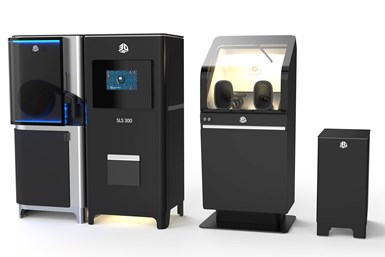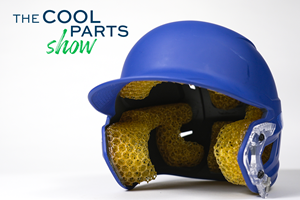3D Systems’ SLS 300 Enables Advanced SLS Technology in Smaller Manufacturing Environments
A new Powder Recycling Station (PRS) is an optional accessory available in 2024 which works in tandem with the printer to automatically recycle unused powder currently in the system and mix it with fresh material.
3D Systems has expanded its selective laser sintering (SLS) portfolio with the SLS 300, which is an affordable, turnkey, closed-loop system. The SLS 300 is designed to operate in a smaller footprint environment outside of a manufacturing floor, such as offices, material research labs or workshops. This makes SLS available to a broader range of customers with a high-reliability, affordable solution for the production of end-use parts.
The SLS 300 (formerly the Wematter Gravity) makes it possible to accelerate product development and in-house volume production with increased flexibility, lower risk, and reduced manufacturing and development costs. The system is an easy-to-install ecosystem that only requires a standard power source and an ethernet connection to be operational in less than an hour.
The system is well suited for prototypes, functional parts, small complex parts, parts for the automotive industry, medical supplies, pipelines and fittings for water pipes, and industrial components. The system is compatible with a broad material portfolio to address a breadth of applications. Users can produce tough, durable parts from a range of production-grade nylon materials. Choose from tough, impact- and fatigue-resistant nylon 11 materials or strong, or flame-retardant nylon 12 thermoplastics and filled nylons.
The patented packaging ensures users do not come into direct contact with any powder when filling the machine. The cylinders, made of sustainable paper and wood-based packaging, directly connect to the printer and fill it via a dedicated inlet on the front to keep the process dust-free. Each cylinder includes a QR card that helps ensure the correct material is loaded into the correct printer.
The system offers a new Powder Recycling Station (PRS) which is an optional accessory planned to be available in 2024. This unit works in tandem with the SLS 300 printer to automatically recycle unused powder currently in the system and mix it with fresh material. It enables the ability to use all material to maximize a user’s investment while lowering production costs and reducing demand for human intervention. The PRS includes HEPA filters and was designed with acoustic dampening which enables it to be used comfortably in a variety of environments.
The system simplifies SLS Technology with a plug-and-play format. This means users can print SLS-quality functional prototypes, tools and more without the need for specialized staff, investments in infrastructure and complex powder handling. The SLS also prints parts with mechanical properties as strong as injection molding without the need for complex infrastructure or expertise. It uses standard power, is low in office noise levels and requires no chiller or fume extractor.
This customizable 3D printing solution is available in two packages with optional accessories. The SLS 300 offers a 300 × 300 × 150-mm build volume at 10 mm/hr. It supports PA11 Black material. The SLS 300 Plus offers a 300 × 300 × 300-mm build volume at 12 mm/hr. It comes with an Essential Plus Toolset and supported materials include PA11 Black, PA11 Natural and PA12. Optional Accessories available with both the SLS 300 and SLS 300 Plus package include a Powder Vacuum and a Water Jet Cabinet.
Because of its patented packaging, users do not come into direct contact with any powder when filling the machine. Users can also work remotely, starting and monitoring print jobs remotely to increase productivity and resource consumption. The systems is easy to use with a simple user interface that guides operators through the end-to-end printing process to maximize uptime and productivity.
It also features an integrated touchscreen with contextual help guides. With the Wemote control panel, users can keep track of everything they need on a 13" inch touchscreen. An integrated camera enables operators monitor ongoing print jobs and shows estimated finishing time and status. Contextual help guides instruct users through steps such as loading the printer with new powder, cleaning the chamber or extracting finished parts from the build.
An Atmosphere Generator provides improved control of build chamber conditions in the printer for increased part density, surface finish and mechanical performance. It communicates with the SLS 300’s software to create a more stable thermal environment during the printing process.
The optional Water Jet Cabinet provides efficient depowdering. It cleans and extracts powder fast and conveniently using a water spray gun containing different nozzles to clean cavities, surfaces and smaller details. Built-in moisture control keeps a safe environment along with filters and sterilization for built-in water purification.
- Read about 3D Systems’ Accura AMX Resin which can withstands harsh thermal environments. The resin material is well suited for the testing of high-temperature components in applications such as HVAC, consumer appliances, motor enclosures, fixtures, mounts, stators, molding/tooling and more.
- Check out this article about 3D Systems Verifying the performance of NASA’s GRX-810 Super Alloy. This oxide dispersion-strengthened alloy, developed by NASA, demonstrates exceptional mechanical properties and resistance to extreme temperatures, making it well suited for future use in critical components such as rocket engines, turbine blades and exhaust nozzle components.
Related Content
ActivArmor Casts and Splints Are Shifting to Point-of-Care 3D Printing
ActivArmor offers individualized, 3D printed casts and splints for various diagnoses. The company is in the process of shifting to point-of-care printing and aims to promote positive healing outcomes and improved hygienics with customized support devices.
Read More3D Printed Spine Implants Made From PEEK Now in Production
Medical device manufacturer Curiteva is producing two families of spinal implants using a proprietary process for 3D printing porous polyether ether ketone (PEEK).
Read More3D Printed Lattices Replace Foam for Customized Helmet Padding: The Cool Parts Show #62
“Digital materials” resulting from engineered flexible polymer structures made through additive manufacturing are tunable to the application and can be tailored to the head of the wearer.
Read MoreCopper, New Metal Printing Processes, Upgrades Based on Software and More from Formnext 2023: AM Radio #46
Formnext 2023 showed that additive manufacturing may be maturing, but it is certainly not stagnant. In this episode, we dive into observations around technology enhancements, new processes and materials, robots, sustainability and more trends from the show.
Read MoreRead Next
Crushable Lattices: The Lightweight Structures That Will Protect an Interplanetary Payload
NASA uses laser powder bed fusion plus chemical etching to create the lattice forms engineered to keep Mars rocks safe during a crash landing on Earth.
Read MorePostprocessing Steps and Costs for Metal 3D Printing
When your metal part is done 3D printing, you just pull it out of the machine and start using it, right? Not exactly.
Read MoreProfilometry-Based Indentation Plastometry (PIP) as an Alternative to Standard Tensile Testing
UK-based Plastometrex offers a benchtop testing device utilizing PIP to quickly and easily analyze the yield strength, tensile strength and uniform elongation of samples and even printed parts. The solution is particularly useful for additive manufacturing.
Read More





















